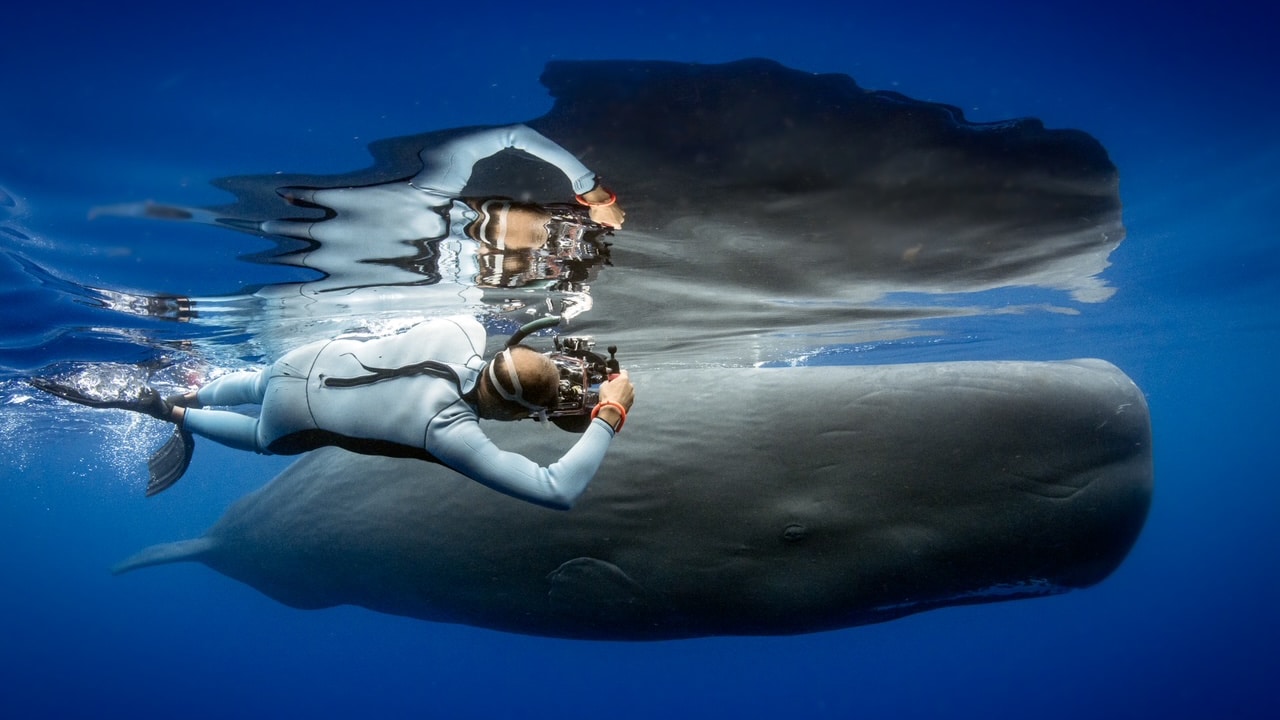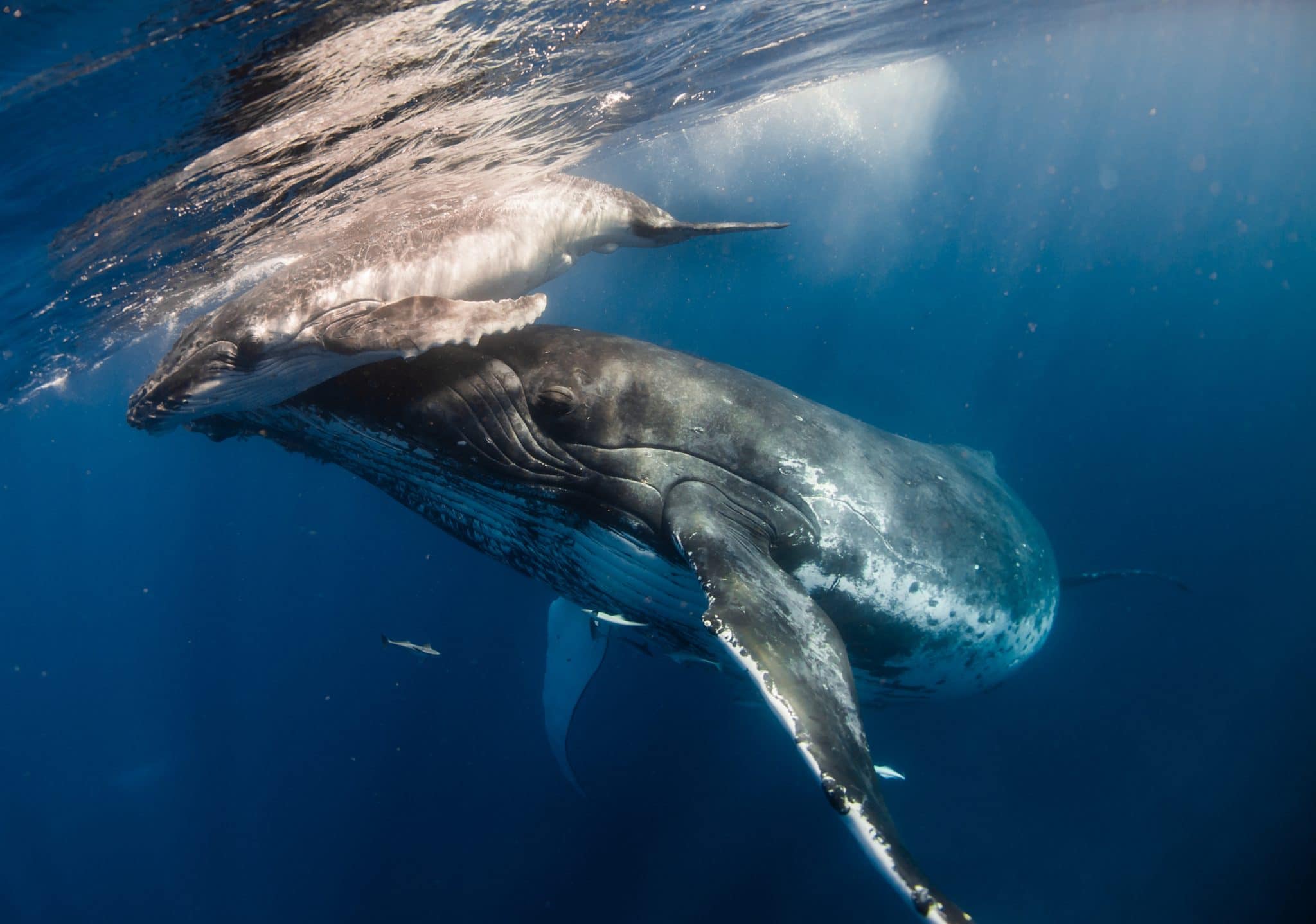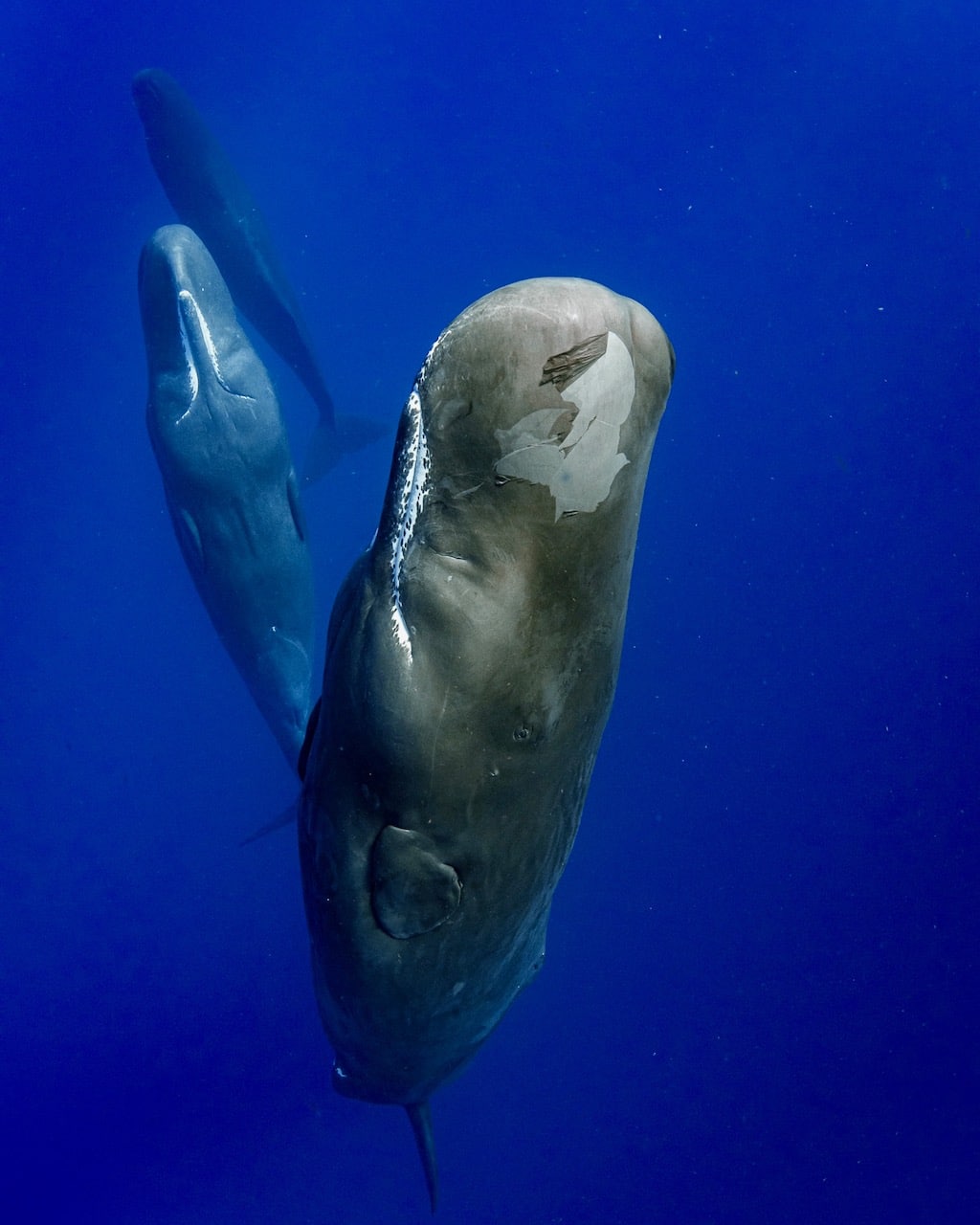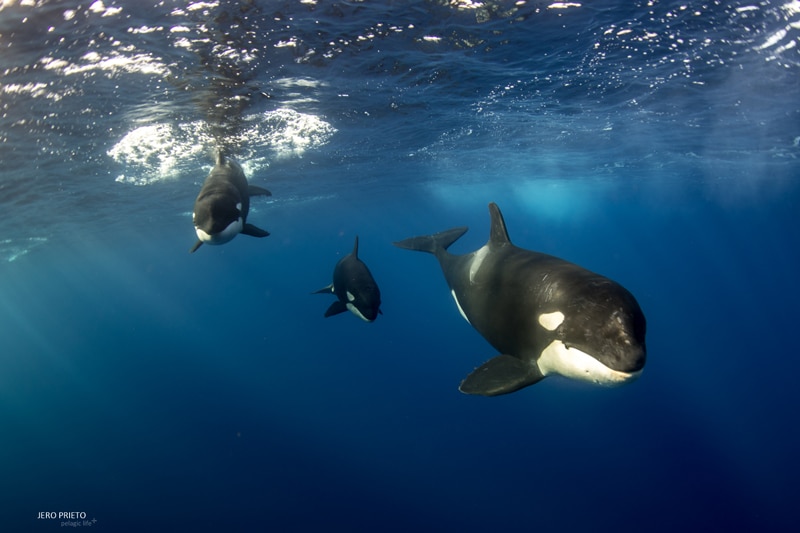Marine Life & Conservation Blogs
A Guide to Swimming with Whales

A guest blog from PADI to mark World Whale Day
There’s nothing more magical than an encounter with a gentle giant underwater. Looking into their all-knowing eyes, you’ll quickly realize you are a visitor in their world! Supporting responsible whale tourism around the world is a great way to support local conservation efforts and catch a glimpse of the ocean’s largest ambassadors.
As protected species in most of the waters of the world, often you are limited to viewing whales from afar on the deck of a boat. But if your dreams of swimming with whales run deep, then PADI, the world’s largest diving organisation with over 6,600 dive centers and resorts, can make those dreams come true.
In some parts of the world, it’s possible to not just view them from the deck of a boat, but to enter the water and responsibly swim with them – often without any dive training required!
From sperm whales to humpbacks to the charismatic orcas (who are actually dolphins but definitely deserve a spot on the list), these are the places around the world where it’s possible to meet a whale underwater. Why not celebrate this World Whale Day (Feb 20th 2022) by planning your dream adventure now.
Where to Swim with Humpback Whales
Humpbacks are famous for their mesmerizing whale songs, which can be heard by other whales many thousands of miles away. Growing 50 to 60 feet long, they are strong swimmers that can propel themselves completely out of the water and into the air (aka “breaching”). Getting their name from the small hump in front of their dorsal fin, the underside of each whale is unique in its pattern and pigmentation. Perhaps the coolest thing about humpbacks (besides their crazy water acrobatics) is that they are known to blow bubbles in order to confuse and catch fish!
Their long migrations lead them from the poles to the equator, allowing whale lovers to have close encounters along many diverse coastlines. While there are pretty tight regulations against swimming with humpbacks in much of the world, here are a few where it is legal through sustainable tourism operators.
1. Tonga: July -October
Every July through October, huge numbers of humpbacks travel north from Antarctica to Tonga to mate and calf. The best places to swim with the whales from my experience are the islands of Vava’u or Ha’apai. Only a handful of boat operators receive permits to go near the whales each year, and each boat can only take a small number of people, so booking your trip early is important.
2. Tahiti, French Polynesia: August – October
From August to October each year, humpbacks travel to Tahiti to birth their calves in the calm, warm waters off the island. Today, French Polynesia is a designated shark sanctuary and exclusive economic zone (EEZ) in order to protect its incredible marine life. Tahiti and Mo’orea are the main spots to swim with whales, offering both daily swim experience that also include the extra options of swimming in waterfalls and swimming with rays.
3. Western Australia: June – November
From June to November each year, approximately 40,000 whales migrate along the coastline of Ningaloo Marine Park, including Ningaloo Reef, in order to feed at the poles. Also referred to as Australia’s coral coast, Ningaloo is the site of a thriving coral reef which is home to other marine life including dolphins, rays, and turtles. Tours here take small groups on full day excursions to swim with the migrating whales and are designed to have little to no impact on the marine environment.
4. South Africa + Mozambique: July-October
Hundreds of humpback whales travel up the coast from Durban to Mozambique each July through October to mate and calf in the Indian Ocean. The coastal town of Tofo, which is also known for its population of whale sharks, is a great home base, where you can both snorkel and dive with the whales, as well as the countless other marine creatures that call the area home. Or you can catch them off the coast of South Africa during the infamous and epic sardine run.
5. Dominican Republic: January – April
The Dominican Republic’s Silver Bank is in a 650-square-mile marine sanctuary (now expanded as part of the “Sanctuary for the Marine Mammals of the Dominican Republic”) located about 50 miles north of the island. A large population of North Atlantic humpbacks gather here each winter and spring to mate and calf from the months of January through April. Take a week-long yacht trip to Silver Bank for the chance to to swim with the whales every day during the trip.
Where to Swim with Sperm Whales
Sperm whales are the largest of the toothed whales, as they can grow to be nearly 60 feet long, and are recognizable by their huge, rounded foreheads. They can dive down more than 3,000 feet (deeper than nearly all other whales) and hold their breath for 90 minutes, which helps them in their quest to eat giant squid and 2,000 pounds of fish per day. Female whales and their calves travel in groups of 15 to 20, while male sperm whales usually travel on their own. They are the loudest animals on the planet, as the clicking sounds they make reach such an intense frequency (more than 200 dB) that the whales can hear each other’s clicks from thousands of miles away. (To a human, sounds over 110 dB can be painful, so sperm whale sounds could blow out your eardrums!) They’re not just loud, though, but also highly intelligent. A sperm whale’s brain is approximately six times the size of a human brain, making it the largest brain of any animal on Earth! (Another fun fact: the whale in Moby Dick is a sperm whale.)
Given that they dive down so deep and can be shy, the best way to swim with them is to find a group of ‘standing’ sperm whales, which is how they sleep. Through and through, sperm whales are gentle giants who sometimes even take interest in interacting with humans.
1. Dominican Republic: Winter Months
In the winter, females and their calves can be spotted off the shores of this Caribbean island nation, which is located halfway between the islands of Guadeloupe and Martinique. Swimming with these whales requires some pre-planning: permits are required, only snorkeling is allowed, and you must be accompanied by a licensed operator.
2. Sri Lanka: February – April
Off the northern coast of Sri Lanka, sperm whales can be spotted from February to April. Tour operators need to obtain a permit from the Sri Lankan government, with the majority of tours organised as a whale watching tours. But if you get lucky enough, there are a few that focus on actually swimming with these mystical creatures.
(*fun fact: Sri Lanka is also one of the only countries in the world where you can swim with the biggest mammal in the world, the blue whale. They aren’t particularly interactive, so your best bet is to jump in the water as it passes by, like a freight train, underneath you.)
Where to Swim with Orcas
Often called killer whales, orcas are actually in the dolphin family, but they deserve a spot on this list because they’re beautiful, amazing and a once-in-a-lifetime opportunity to swim with. While known to be some of the deadliest creatures in the ocean, they are equally some of the most intelligent. They can even hunt great white sharks! Orcas travel in pods of up to 40, so if you see one, there’ll be dozens more close by.
1. Norway: October – February
From the end of October to the beginning of February, the Tromsø region in the far north of Norway is perhaps the best place to see killer whales in their natural habitat, thanks to the high concentration of herring which brings thousands of orcas (and humpbacks, too) all to one geographical location. Scuba diving typically is not necessary, as the whales remain pretty close to the surface, but snorkeling and swimming are common each winter. Luckily, the orcas are not on the hunt for anything but fish, so they won’t take any interest in you. Because an adventure like this must be so tightly planned and regulated, spots are few and planning ahead is important. Booking online is easy, though, and there are many tours and excursions to choose from.
2. Baja California Sur: All Year Long
Baja California Sur’s magical waters offer an incredible array of opportunities to swim with all sorts of marine life, including orcas. You can easily hop on an exploratory trip with PADI Dive Center Dive Ninja Expeditions with the goal of finding resident pods of orcas that live and hunt off the coastline. There are on average, three core pods of orcas that swim through these waters, making an encounter with them highly likely!
Header Image: Jay Clue / Dive Ninja Expeditions
Blogs
Invitation from The Ocean Cleanup for San Francisco port call

6 years ago, The Ocean Cleanup set sail for the Great Pacific Garbage Patch with one goal: to develop the technology to be able to relegate the patch to the history books. On 6 September 2024, The Ocean Cleanup fleet returns to San Francisco bringing with it System 03 to announce the next phase of the cleanup of the Great Pacific Garbage Patch and to offer you a chance to view our cleanup system up-close and personal.
We look forward to seeing you there.
To confirm your presence, please RSVP to press@theoceancleanup.com
PROGRAM
Join The Ocean Cleanup as our two iconic ships and the extraction System 03 return to San Francisco, 6 years and over 100 extractions after we set sail, to create and validate the technology needed to rid the oceans of plastic.
Our founder and CEO, Boyan Slat, will announce the next steps for the cleanup of the Great Pacific Garbage Patch. Giving you a chance to view our cleanup system and the plastic extracted.
Hear important news on what’s next in the mission of The Ocean Cleanup as it seeks to make its mission of ridding the world’s oceans of plastic an achievable and realistic goal.
Interviews and vessel tours are available on request.
PRACTICALITIES
Date: September 6, 2024
Press conference: 12 pm (noon)
Location: The Exploratorium (Google Maps)
Pier 15 (Embarcadero at Green Street), San Francisco, CA
Parking: Visit The Exploratorium’s website for details.
RSVP: press@theoceancleanup.com
Video & photo material from several viewing spots around the bay
We look forward to seeing you there!
ABOUT THE OCEAN CLEANUP
The Ocean Cleanup is an international non-profit that develops and scales technologies to rid the world’s oceans of plastic. They aim to achieve this goal through a dual strategy: intercepting in rivers to stop the flow and cleaning up what has already accumulated in the ocean. For the latter, The Ocean Cleanup develops and deploys large-scale systems to efficiently concentrate the plastic for periodic removal. This plastic is tracked and traced to certify claims of origin when recycling it into new products. To curb the tide via rivers, The Ocean Cleanup has developed Interceptor™ Solutions to halt and extract riverine plastic before it reaches the ocean. As of June 2024, the non-profit has collected over 12 million kilograms (26.4 million pounds) of plastic from aquatic ecosystems around the world. Founded in 2013 by Boyan Slat, The Ocean Cleanup now employs a broadly multi-disciplined team of approximately 140. The foundation is headquartered in Rotterdam, the Netherlands, and opened its first regional office in Kuala Lumpur, Malaysia, in 2023.
Find out more about The Ocean Cleanup at www.theoceancleanup.com.
Blogs
Smart Shark Diving: The Importance of Awareness Below the Surface

By: Wael Bakr
Introduction to Shark Diving Awareness
In the realm of marine life, few creatures captivate our interest, and sometimes our fear, like the shark. This fascination often finds a home in the hearts of those who venture beneath the waves, particularly scuba divers who love shark diving. It’s here that shark awareness takes the spotlight. Shark awareness is not just about understanding these magnificent creatures; it’s about fostering respect, dispelling fear, and promoting conservation. As Jacques Cousteau once said, “People protect what they love.” And to love something, one must first understand it.
Shark awareness is not a mere fascination; it’s a responsibility that we owe to our oceans and their inhabitants. From the smallest reef shark to the colossal great white, each species plays a crucial role in the underwater ecosystem. Our understanding and appreciation of these creatures can help ensure their survival.
However, shark awareness isn’t just about protecting the sharks; it’s also about protecting ourselves. As scuba divers, we share the underwater world with these magnificent creatures. Understanding them allows us to dive safely and responsibly, enhancing our experiences beneath the waves.
Importance of Shark Awareness in Scuba Diving
The relevance of shark awareness in scuba diving cannot be overstated. Sharks, like all marine life, are an integral part of the underwater ecosystem. Their presence and behavior directly influence our experiences as divers. By understanding sharks, we can better appreciate their role in the ocean, anticipate their actions, and reduce potential risks.
Awareness is crucial for safety when shark diving. Despite their often-misunderstood reputation, sharks are generally not a threat to humans. However, like any wild animal, they can pose risks if provoked or threatened. By understanding shark behavior, we can identify signs of stress or aggression and adjust our actions accordingly. This not only protects us but also respects the sharks and their natural behaviors.
Moreover, shark awareness enriches our diving experiences. Observing sharks in their natural habitat is a thrilling experience. Understanding them allows us to appreciate this spectacle fully. It’s not just about seeing a shark; it’s about understanding its role in the ecosystem, its behavior, and its interaction with other marine life. This depth of knowledge adds a new dimension to our diving experiences.
Understanding Shark Behavior: The Basics
The first step in shark awareness is understanding shark behavior. Sharks are not the mindless predators they are often portrayed to be. They are complex creatures with unique behaviors and communication methods. Understanding these basics can significantly enhance our interactions with them.
Sharks communicate primarily through body language. By observing their movements, we can gain insights into their mood and intentions. For example, a relaxed shark swims with slow, fluid movements. In contrast, a stressed or agitated shark may exhibit rapid, jerky movements or other signs of discomfort such as gill flaring.
Sharks also use their bodies to express dominance or assertiveness. A dominant shark may swim with its pectoral fins pointed downwards, while a submissive shark may swim with its fins flattened against its body. Understanding these signals can help us interpret shark behavior accurately and respond appropriately.
How Shark Awareness Enhances Scuba Diving Experiences
Shark awareness significantly enhances our scuba diving experiences. It transforms encounters with sharks from mere sightings into meaningful interactions. Knowledge is power, and in this case, it’s the power to appreciate, respect, and safely interact with one of the ocean’s most fascinating inhabitants.
A thorough understanding of behavior when shark diving allows us to interpret their actions and responses accurately. It enables us to recognize signs of stress or aggression and adjust our behavior accordingly. This not only ensures our safety but also promotes responsible interactions that respect the sharks and their natural behaviors.
Furthermore, shark awareness adds a new layer of depth to our diving experiences. It’s one thing to see a shark; it’s another to understand its behavior, its role in the ecosystem, and its interactions with other marine life. This depth of understanding enriches our experiences and fosters a deeper appreciation for our underwater world.
Misconceptions About Sharks: Busting the Myths
Unfortunately, sharks are often misunderstood, feared, and even demonized. These misconceptions can be detrimental, not only to our experiences as divers but also to shark conservation efforts. As part of shark awareness, it’s important to debunk these myths and present sharks in their true light.
First and foremost, sharks are not mindless killing machines. They are complex creatures with unique behaviors and communication methods. They are not interested in humans as prey and, in most cases, prefer to avoid us.
Secondly, not all sharks are dangerous. Out of over 500 species of sharks, only a handful are considered potentially harmful to humans. Most sharks are harmless, and even those that can pose a threat are unlikely to attack unless provoked.
Lastly, sharks are not invincible. They are vulnerable to a host of threats, most notably human activities such as overfishing and habitat destruction. They need our understanding and protection, not our fear and persecution.
Shark Behavior: What to Expect When Scuba Diving
When scuba diving, it’s important to know what to expect from sharks. Most encounters with sharks are peaceful and awe-inspiring. However, as with any wild animal, it’s essential to be prepared and understand their behavior.
Most sharks are shy and cautious creatures. They are likely to observe you from a distance, often circling around to get a better look. This is normal behavior and not a sign of aggression.
However, if a shark becomes agitated or feels threatened, it may exhibit signs of stress such as rapid, jerky movements or gill flaring. In such cases, it’s essential to remain calm, avoid sudden movements, and slowly retreat if possible.
Remember, every encounter with a shark is an opportunity to observe and learn. With understanding and respect, these encounters can be safe, enriching, and truly unforgettable experiences.
Practical Tips for Shark Awareness During Scuba Diving
Being aware of sharks during scuba diving is about more than just understanding their behavior. It’s about applying this knowledge in practical ways to ensure safe and respectful interactions. Here are a few tips for shark awareness during scuba diving.
Firstly, always observe sharks from a safe distance. Avoid approaching them directly or making sudden movements, as this can startle or threaten them.
Secondly, never attempt to touch or feed sharks. This can disrupt their natural behavior and potentially put you at risk.
Lastly, always respect the sharks and their environment. Avoid disturbing their habitat or interfering with their natural behaviors. Remember, we are visitors in their world.
Promoting Shark Conservation through Scuba Diving
Scuba diving offers a unique platform for promoting shark conservation. As divers, we have the privilege of witnessing the beauty and complexity of sharks firsthand. We can share these experiences with others, fostering understanding and appreciation for these magnificent creatures.
Moreover, we can actively contribute to shark conservation. Many diving operators offer opportunities to participate in shark research and conservation initiatives. By participating in these programs, we can help ensure the survival of sharks for future generations.
Lastly, we can advocate for sharks. By sharing our knowledge and experiences, we can help dispel misconceptions about sharks and promote their protection. Every voice counts in the fight for shark conservation.
Courses and Resources for Shark Awareness and Behavior
There are many resources available for those interested in shark awareness and behavior. Scuba Diving International as well as numerous conservation-based organizations offer courses and workshops on shark biology, behavior, and conservation. These courses provide in-depth knowledge and practical skills for interacting with sharks responsibly and safely. From courses like our Marine Ecosystems Awareness Specialty and our Advanced Adventure Certification provide you with the information you need to tackle this new challenge!
Additionally, there are many online resources available, including websites, blogs, and forums dedicated to shark awareness and conservation. These platforms offer a wealth of information and a community of like-minded individuals passionate about sharks.
I encourage anyone interested in sharks to explore these resources, to sign up for one of SDI’s courses call your local dive center or instructor or reach out to your regional representative/ World HQ to find where the class is being taught near you. Knowledge is the first step towards understanding, appreciation, and conservation.
Conclusion: The Role of Shark Awareness in Future Scuba Diving Experiences
As we look to the future, the role of shark awareness in scuba diving will only continue to grow. As our understanding of these magnificent creatures deepens, so too will our appreciation and respect for them. This knowledge will shape our interactions with sharks, enhancing our experiences and promoting responsible and respectful behavior.
Shark awareness is more than just an interest; it’s a responsibility. It’s a commitment to understanding, respecting, and protecting one of the ocean’s most fascinating inhabitants. And it’s a journey that I invite all divers to embark on.
As we dive into the blue, let’s dive with awareness. Let’s dive with respect. And let’s dive with a commitment to understand and protect our underwater world. For in the end, the ocean’s health is our health, and every creature within it, including the sharks, plays a crucial role in maintaining this delicate balance.
-

 Blogs2 months ago
Blogs2 months agoDiving With… Nico, Ocean Earth Travels, Indonesia
-

 News1 month ago
News1 month agoMurex Bangka Announce New Oceanfront Cottages & Beachfront Dining
-

 Blogs2 months ago
Blogs2 months agoA new idea in freediving from RAID
-

 Marine Life & Conservation1 month ago
Marine Life & Conservation1 month agoIceland issue millionaire whale hunter a licence to murder 128 vulnerable fin whales
-

 Marine Life & Conservation2 months ago
Marine Life & Conservation2 months agoThe Shark Trust Great Shark Snapshot is back
-

 News3 months ago
News3 months agoCharting New Waters; NovoScuba Goes Global with the Launch of their Revolutionary Dive Training Agency!
-

 Gear News1 month ago
Gear News1 month agoNew Suunto Ocean – a dive computer and GPS sports watch in one for adventures below and above the surface
-

 Marine Life & Conservation Blogs2 months ago
Marine Life & Conservation Blogs2 months agoBook Review: Plankton


















